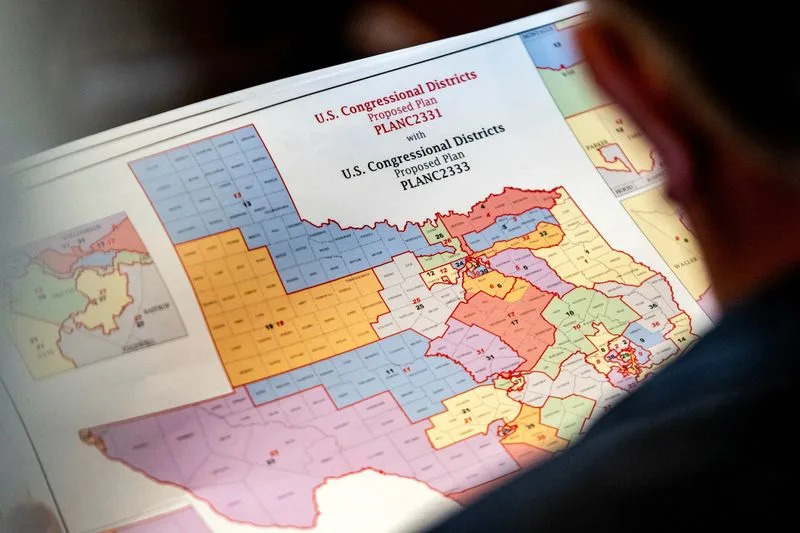
By Jan Wolfe
WASHINGTON (Reuters) -Texas lawmakers approved a new congressional map this week at the behest of President Donald Trump, seeking to preserve his Republican Party's slim majority in the U.S. House of Representatives in the November 2026 midterm elections.
In response, the California Senate on Thursday moved forward with legislation to give Democrats five more House seats in the state.
Here's what to know about the court fights that are brewing.
CAN TEXAS LEGALLY REDRAW ITS VOTING DISTRICTS?
A panel of three federal judges is expected to hold a hearing as soon as September to determine the legality of the new congressional district map approved by the Republican-controlled legislature in Texas.
In a Monday court filing, a coalition of left-leaning voting rights groups said they plan to ask the U.S. District Court in El Paso to block the map from taking effect on the grounds that it is racially discriminatory.
The plaintiffs asked a three-judge panel to set aside time in September for the hearing so that litigation can move quickly. The panel has not yet ruled on the request.
Under federal law, challenges to the constitutionality of a congressional map are heard by a federal three-judge panel rather than a single district court judge. A panel ruling can then be appealed directly to the U.S. Supreme Court, bypassing an intermediate appeals court.
WHAT ARE TEXAS DEMOCRATS ARGUING?
Texas Democrats and voting rights groups are focusing on a claim that the map unconstitutionally packs Black and Latino voters - who are driving Texas’ population growth - into some districts while spreading them throughout others to dilute their voting power.
Section 2 of the Voting Rights Act, a landmark 1965 law, allows voters to seek judicial relief if they believe that a state government has curtailed voting rights on the basis of race.
The Voting Rights Act was a key achievement of the U.S. civil rights movement of the 1960s led by Martin Luther King Jr. The legislation broadly prohibited poll taxes, literacy tests and other measures common in states with a history of slavery that prevented black people from voting.
The U.S. Supreme Court has struck down some parts of the Voting Rights Act, but reaffirmed the validity of Section 2 in a 5-4 decision from 2023.
Texas Governor Greg Abbott, a Republican and a Trump ally, has rejected the racial discrimination allegations, saying the new map actually empowers minority voters.
“It’s a proven fact that minority voters chose to vote for Trump as well as other Republicans, but they are trapped in one of these gerrymander districts that confines it only to electing a Democrat,” Abbott said during a Fox News interview on August 10.
Democrats are focusing on the racial discrimination claim because the Supreme Court ruled in 2019 that federal judges are powerless to hear challenges to partisan gerrymandering, the practice in which the political party that controls the state legislature draws a voting map to help elect its candidates.
WHAT IS CALIFORNIA'S PLAN?
California lawmakers on Thursday passed a series of bills aimed at creating newly drawn congressional maps that would flip Republican-held seats to the Democrats.
Unlike Texas, where the legislature draws voting maps, California relies on a citizen redistricting commission protected by the state's constitution. But Democrats in the state legislature say they can bypass this bipartisan commission so long as voters approve the new map in a statewide special election. A referendum is expected to be held in November.
COULD CALIFORNIA'S PLAN BE BLOCKED IN COURT?
While California's plan to have a special election appears to be lawful, it could be derailed by procedural challenges.
Democrats need to move quickly with their redistricting effort for it to be in effect before the midterm elections in November 2026. The party of the incumbent president typically loses House seats in midterm elections, which can block their legislative agendas and in Trump's first term led to two impeachment probes.
In a lawsuit filed on Tuesday, a group of Republican lawmakers said their Democratic colleagues are violating a provision of the state's constitution requiring a minimum 30-day waiting period between when a bill is introduced and when it is acted on by lawmakers.
Instead of a transparent and participatory process, "the public would be presented instead with an up or down vote on maps unilaterally prepared in secret by the legislature,” stated the emergency petition.
California Democrats have said they are using commonplace, lawful tactics to expedite their legislation calling for a special election to approve the redistricting plan.
(Reporting by Jan Wolfe; Editing by Amy Stevens and Sonali Paul)







Comments